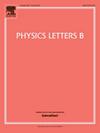First law of black holes in the gravitational electromagnetic system with magnetic charge
IF 4.3
2区 物理与天体物理
Q1 ASTRONOMY & ASTROPHYSICS
引用次数: 0
Abstract
The quantum corrections in Einstein-Maxwell theory are typically described by introducing higher-curvature terms and non-minimally coupled electromagnetic fields. Our paper investigates the first law of dyonic black holes in the four-dimensional gravitational electromagnetic system with the Lagrangian . In previous studies, the magnetic “potential-charge” term in the first law of dyonic black holes was primarily obtained directly from the analytic solutions of black holes or through Komar integral variations in Einstein gravity, with limited applicability. Our analysis reveals that the failure of the Iyer-Wald method to derive the magnetic “potential-charge” term is mainly due to the assumption that the electromagnetic vector potential is regular at the axial poles. Consequently, without requiring regularity of the electromagnetic vector potential at the future Killing horizon and axial poles, we generally derive the first law of asymptotically flat stationary-axisymmetric black holes, which includes both electric and magnetic “potential-charge” terms. Finally, we apply our findings to the general quadric corrected Einstein-Maxwell theory. Our results indicate that the first law with the magnetic charge of black holes might be valid for the Einstein-Maxwell theory with some quantum corrections in the effective region.
求助全文
约1分钟内获得全文
求助全文
来源期刊

Physics Letters B
物理-物理:综合
CiteScore
9.10
自引率
6.80%
发文量
647
审稿时长
3 months
期刊介绍:
Physics Letters B ensures the rapid publication of important new results in particle physics, nuclear physics and cosmology. Specialized editors are responsible for contributions in experimental nuclear physics, theoretical nuclear physics, experimental high-energy physics, theoretical high-energy physics, and astrophysics.
 求助内容:
求助内容: 应助结果提醒方式:
应助结果提醒方式:


